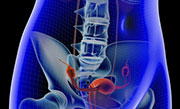More deaths from leiomyosarcoma after laparoscopic hysterectomy; lower rates of complications
FRIDAY, March 27, 2015 (HealthDay News) — Laparoscopic hysterectomy with morcellation is associated with better outcomes than abdominal hysterectomy for women with presumed fibroid tumors, according to research published online March 24 in the American Journal of Obstetrics & Gynecology.
Matthew T. Siedhoff, M.D., from the University of North Carolina at Chapel Hill, and colleagues modeled outcomes for laparoscopic hysterectomy with morcellation versus abdominal hysterectomy for the presumed fibroid uterus. Using a decision-tree analysis, outcomes were compared for a hypothetical cohort of 100,000 premenopausal women who underwent hysterectomy for presumed fibroid tumors over a five-year time horizon.
The researchers predicted fewer overall deaths for laparoscopic hysterectomy versus abdominal hysterectomy (98 versus 103 per 100,000). After laparoscopic hysterectomy there were more deaths from leiomyosarcoma (86 versus 71 per 100,000), while more hysterectomy-linked deaths occurred after abdominal hysterectomy (32 versus 12 per 100,000). The rates of transfusion, wound infection, venous thromboembolism, and incisional hernia were lower in the laparoscopic group, but the rate of vaginal cuff dehiscence was higher. There were more quality-adjusted life-years with laparoscopic hysterectomy (499,171 versus 490,711 over five years).
“No decision analysis is ever the ‘final word,’ and this one in this month’s AJOG is no different,” Editor-in-Chief for Gynecology of the American Journal of Obstetrics & Gynecology Ingrid Nygaard, M.D., of the University of Utah in Salt Lake City, said in a journal news release. “New data will continue to be added to the literature and the conclusions might stand as they are or change. But, most importantly, Siedhoff et al remind us to keep the big picture in mind, to balance risks and benefits of different procedures, and to work vigilantly to decrease the impact of risks to the extent possible.”
Copyright © 2015 HealthDay. All rights reserved.








